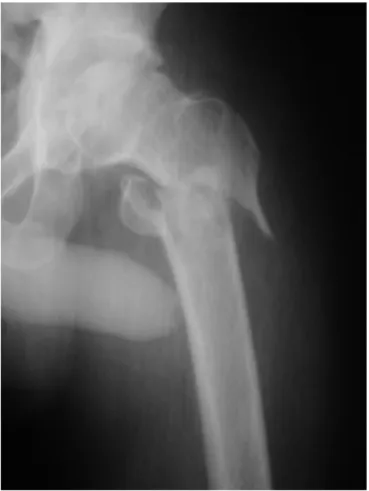w w w . r b o . o r g . b r
Original
Article
Evaluation
of
the
reproducibility
of
the
Tronzo
classification
for
intertrochanteric
fractures
of
the
femur
夽
,
夽夽
Fernando
Abdala
Silva
Oliveira,
Ricardo
Basile
∗,
Bruno
Cézar
Brabo
Pereira,
Rafael
Levi
Louchard
Silva
da
Cunha
CarminoCaricchioMunicipalHospital,SãoPaulo,SP,Brazil
a
r
t
i
c
l
e
i
n
f
o
Articlehistory:
Received24September2013 Accepted21November2013 Availableonline7November2014
Keywords:
Femoralfractures/classification Femoralfractures/radiographs Reproducibilityoftests
a
b
s
t
r
a
c
t
Objective:To evaluate the inter-observerreproducibility of the Tronzo classificationfor transtrochantericfracturesusingthekappaconcordancecoefficient().
Methods:Twentyradiographicimagesinanteroposteriorviewonhipswithtranstrochanteric fracturesofthefemurwereused.Thesewereclassifiedby12observersusingtheTronzo method.Theimageswerepresentedinsequenceandaquestionnairecontainingallthe options oftheTronzoclassificationwasfilled out,alongwithasimplifiedclassification usingTronzodivisionsintotwogroups(stableandunstable).Thedatawereanalyzedby meansofthekappaconcordancetest.
Results:Thefollowingkappaindiceswerefound:forimageswithstablefractures(Tronzo1 and2),0.11;forimageswithunstablefractures(Tronzo3,3variant,4and5),0.52;andforthe completeclassification,0.44(moderateconcordance).Inturn,thesimplifiedclassification didnotincreasetheconcordancerates.
Conclusion: TheTronzoclassification isunsuitableforclinicalpractice.We suggestthat anothersystemshouldbeusedorcreatedforthistypeoffracture.
©2014SociedadeBrasileiradeOrtopediaeTraumatologia.PublishedbyElsevierEditora Ltda.Allrightsreserved.
Avaliac¸ão
da
reprodutibilidade
da
classificac¸ão
de
Tronzo
para
fraturas
intertrocantéricas
do
fêmur
Palavras-chave:
Fraturasdofêmur/classificac¸ão Fraturasdofêmur/radiografias Reprodutibilidadedostestes
r
e
s
u
m
o
Objetivo:Avaliara reprodutibilidade, interobservadores, da classificac¸ãode Tronzopara fraturastranstrocantéricascomousodocoeficientedeconcordânciakappa().
Métodos:Foram usadas 20 imagens de radiografias do quadril na incidência antero-posterior com fraturas transtrocantéricasdo fêmur, classificadas, segundo Tronzo,por
夽
Pleasecitethisarticleas:OliveiraFAS,BasileR,PereiraBCB,daCunhaRLLS.Avaliac¸ãodareprodutibilidadedaclassificac¸ãodeTronzo parafraturasintertrocantéricasdofêmur.RevBrasOrtop.2014;49:581–585.
夽夽
WorkdevelopedintheHipGroupoftheCarminoCaricchioMunicipalHospital,SãoPaulo,SP,Brazil. ∗ Correspondingauthor.
E-mail:ricardo-basile@uol.com.br(R.Basile).
http://dx.doi.org/10.1016/j.rboe.2014.11.001
582
rev bras ortop.2014;49(6):581–58512observadores.Asimagensforamapresentadasemsequênciaefoipreenchidoum ques-tionáriocomtodasasopc¸õesdaclassificac¸ãodeTronzo,alémdaclassificac¸ãosimplificada, comadivisãodeTronzoemdoisgrupos(estáveiseinstáveis).Osdadosforamanalisados pormeiodotestedeconcordânciadekappa.
Resultados: Foramencontradososseguintesíndicesdekappa:paraimagenscomfraturas estáveis(Tronzo1e2),0,11;paraimagenscomfraturasinstáveis(Tronzo3,3variante,4 e5),0,52;eparaaclassificac¸ãocompleta,0,44(concordânciamoderada).Porsuavez,a classificac¸ãosimplificadanãoaumentouosíndicesdeconcordância.
Conclusão: Aclassificac¸ãodeTronzonãoéadequadaparaapráticaclínica.Sugerimosouso ouacriac¸ãodeoutrosistemaparaessetipodefratura.
©2014SociedadeBrasileiradeOrtopediaeTraumatologia.PublicadoporElsevier EditoraLtda.Todososdireitosreservados.
Introduction
Transtrochantericfracturesofthefemuroccurintheregion betweenthegreaterand lessertrochantersofthe proximal femurandareexclusivelyextracapsular.1InBrazil,ina sur-veyconductedbytheMinistryofHealththroughtheNational HealthSystem(SUS),itwasfoundthat90%ofthefunding des-tinedfororthopedicdiseaseswasconsumedbyninediseases, whichincludedtranstrochantericfractures.2
Theirconsequencesforsocietyarealarming.Around one-thirdofthepatientsdieduringthefirstyearaftertheinjury, approximately50%becomeincapableofwalkingunaidedor goingupstairsand20%starttoneedcontinualhomecare.3
Several systems have been used to classify transtrochanteric fractures and thus guide their treat-ment.ThecommonestofthesearetheTronzo,4Evans5,6and AOclassifications.5–7
TheTronzoclassificationiswidelyusedinBrazilian ortho-pedicsandtraumatologyservices.
Exact documentation of the fracture depends on the capacity for radiographic evaluation and classification. Its reproducibilitydependsonthesurgeon’sskillininterpreting aclassificationsystem.Thepositionofthefracturedlimb,the radiographictechniqueandthesurgeons’levelsofexperience arefactorsthatcontributetowardthereproducibilityofa clas-sificationsystem.8
Ideally, a classificationsystem should be easy to apply, reliableandhelpfulinmakingtreatmentdecisions,and con-sequentlyshouldinfluencethefinalresult.Anidealsystem shouldnothaveinterobserverdiscrepancies.9
Therefore, the aim of this study was to assess the interobserverreproducibilityoftheTronzoclassificationfor transtrochantericfracturesofthefemurusingthekappa coef-ficientofconcordance().
Materials
and
methods
A cross-sectional observational study was conducted, in which20radiographicimagesofhipswithtranstrochanteric fracturesofthefemur,inanteroposteriorview,wereused.All thepatientswereovertheageof65yearsandhadsuffered low-energy trauma. The following were used as exclusion criteriafortheimages:pathologicalfracturescausedbybone
tumors,previoussurgeryintheregionoftheproximalfemur andimagesoftranstrochantericfracturesfrompatientsunder theageof65years.
TheradiographswereclassifiedinaccordancewithTronzo, by12 observers:four specialistswho weremembers ofthe society fororthopedictrauma surgery, fourthird-year resi-dents and four first-year residents of an orthopedics and traumatologyservice.Alloftheseobserversweregivenprior explanationsregardingtheTronzoclassification,withgraphic imagesonspreadsheets.
The radiographs ofthe fractures were presentedin the formofslidesinthePowerPoint®software,insequence, indi-viduallynumberedfromonetotwenty,andeachimagewas analyzedforamaximumof45s.Duringthepresentation,a questionnairewasfilledouttogatherdataonalltheoptions oftheTronzoclassification(Anexo1).
Theseriesofradiographswereanalyzedbymeansofthe completeTronzoclassification(sixtypes).Subsequently,this classificationwassubdividedforanalysisintotwosimple sub-types:stablefractures(TronzoIandII)andunstablefractures (TronzoIII,IIIvariant,IVandV).
In1974,Tronzosubdividedthesefracturesintofivetypes. TypesIandIIwerestable;typeIwasdescribedasan incom-plete transtrochantericfracture,whiletypeIIcould present fracturingofthelessertrochanter,butwithoutposteromedial comminution.TypesIIIandIVpresentedposteromedial com-minution;intypeIII,thediaphysiswasbroughttoamedial positionandproximalcalcarwasfittedtoit.When fractur-ingofthegreatertrochanterwasalsopresent,thesituation wasclassifiedasIIIvariant(Fig.1).IntypeIV,thediaphysis wasbroughttoalateralposition,thefracturelinewasmore verticalandthecomminutionwasgenerallygreater.TypeV hadaninvertedline,fromlateraltomedialandfromdistal toproximal,whichmadethefractureunstable(Fig.2).In pre-sentinghisclassification,Tronzodescribedtheosteosynthesis techniquesproposedforthevarioustypesoffracture.1,4
The datagathered were analyzed statisticallyusing the kappaconcordancetest.ThesoftwareusedcomprisedSPSS V16,Minitab15andExcelOffice2007.
Results
Fig.1–TranstrochantericfractureoftypeIIIvariant.Notethefracturingofthegreatertrochanter.
forimageswithunstablefractures,0.52;andforthecomplete classification,0.44(Table1).
Whenwedividedtheobserversintogroupsconsistingof alltheresidentstogetherversustheorthopedictrauma spe-cialists,wefoundthefollowingresults:forresidents,0.49for thecompleteclassification,0.18forstablefracturesand0.55 forunstablefractures;fororthopedictraumaspecialists,0.39 forcompletefractures,0.20forstablefracturesand0.52for unstablefractures(Table2).
Table1–Concordanceforthetotalsample.
kappa pvalue
Stable 0.11 <0.001
Unstable 0.52 <0.001 Complete 0.44 <0.001
Table2–Concordanceaccordingtotitle.
kappa pvalue
Residents
Stable 0.18 <0.001
Unstable 0.55 <0.001
Complete 0.49 <0.001
Orthopedictraumaspecialists
Stable 0.20 <0.001
Unstable 0.52 <0.001
Complete 0.39 <0.001
Lastly, when wetook into consideration the divisionof
theobserversintoallofthegroups,weobtainedthe follow-ing resultsforthegroupoffirst-year residents:0.50forthe completeclassification,0.24forstablefracturesand0.66for unstable fractures. For the third-yearresidents, the results were0.53forthecompleteclassification,0.37forstable frac-turesand0.51forunstablefractures.Meanwhile,theresultfor orthopedictraumaspecialistswas0.39forthecomplete classi-fication,0.20forstablefracturesand0.52forunstablefractures
(Table3).
Table3–Concordanceaccordingtogroup.
kappa pvalue
First-yearresidents
Stable 0.24 <0.001
Unstable 0.66 <0.001 Complete 0.50 <0.001
Third-yearresidents
Stable 0.37 <0.001
Unstable 0.51 <0.001 Complete 0.53 <0.001
Orthopedictraumaspecialists
Stable 0.20 <0.001
584
rev bras ortop.2014;49(6):581–585Fig.2–RadiographshowingTronzotypeV transtrochantericfracture.
Discussion
Thekappaconcordancecoefficient isoftenused whenthe intra- and interobserver reliability and reproducibility are evaluated.Thiscoefficientprovidespairedproportionsof con-cordancebetweenobservers,whichmaybychancebecorrect. Kappavaluescanrangefrom−1to+1;−1indicatestotal dis-cordance,zeroindicatesafortuitouslevelofconcordanceand +1indicatestotalconcordance.Ingeneralterms,kappavalues below0.5areconsideredunsatisfactory, valuesbetween0.5 and0.75areconsideredadequateandsatisfactoryandvalues above0.75areconsideredexcellent.8
Landisclassifiedkappavaluesasfollows:poor(below0), slight(0–0.2),weak(0.2–0.41),moderate(0.41–0.6),substantial (0.61–0.8)andalmostperfect(0.81–1).10
Theclassificationofafractureisthebasisforthechoice of treatment. Thus, it is important to assess the validity of a classification system. Gusmão et al.11 evaluated the Gardenclassificationsystemforfemoralneckfracturesand foundpoorlyreproducibleconcordance(0.32).Schwartsmann etal.7 didthesame inrelationtothe AOclassificationfor transtrochantericfracturesandfoundweakconcordancefor thecomplete AOclassification(0.34).Pervez etal.5 founda weakconcordanceindex(0.34)fortheEvans/Jensen classifi-cationfortranstrochantericfractures.
InoursearchesintheLilacsandMedlinedatabases,wedid notfindanystudiesthatevaluatedtheconcordanceindexof theTronzoclassification.
ThegreatestdifficultyregardingtheTronzoclassification4 isininterpretingthestabilityofthefracture,sincetheauthor’s description states that the stability isin the comminution of the posteromedial wall, and also that in type II frac-tures(whichareconsideredstable),thelessertrochantermay befractured.Thisprobablyexplainstheinsignificant repro-ducibilityforstablefractures(0.11)thatwefoundinourstudy, whichgaverisetolargebiasintheobservers’classifications oftypeIIandIIIfractures.
Theunstablefracturespresentedahigherdegreeof con-cordancethanshownbythestablefractures(moderate;0.52), betweentheobserversingeneral.Thiscanbeexplainedby Tronzo’sdescriptionsofthepatternsoffracturetypesIVand V,giventhattheyarespecificanddonotleaveroomfordoubt regardingtheirpatternofinstability.
Schipperetal.6studied20fracturesusing15observersto makethecompleteAOclassification.Theinterobserverkappa valuewas 0.33.When theyusedthesimplified AO classifi-cation, thekappa valuewas0.67.They concludedthat the simplifiedAOclassificationhadgoodreproducibilitybutthat this wasnotrepeated inthe completeclassification.Inour study,simplificationofthe Tronzo classificationintostable andunstablefracturesdidnotincreasetheconcordanceindex inrelationtothecompleteclassification.
Fungetal.9reportedthat,unexpectedly,inastudy eval-uatingthereproducibilityoftheEvans/Jensenclassification, increasingexperienceamongtheobserverscorrelatedwitha decliningconcordanceindexandtheyinferredthatthis clas-sification system was unclear or that another system was necessary.
InanotherstudythatassessedtheEvans/Jensen classifica-tionusingfourresidents(twoseniorsandtwojuniors)and52 radiographstoevaluatetheconcordance,Gehrchenetal.12did notfindanydifferencesandtookincreasingexperienceinto consideration.
Schipper et al.6 used the AO classification and did not observeanyappreciabledifferenceintheconcordanceamong differentgroupsofprofessionals(residents,orthopedic sur-geonsandradiologists).
We observeda declineinthe kappa concordanceindex when the increase inthe observers’experience was taken into consideration:0.50forthe first-yearresidents, 0.53for thethird-yearresidentsand0.39fortheorthopedictrauma surgeons.Thisdifferencewasstatisticallyinsignificantwhen the groupsofresidentsweretakeninto consideration.This resultwasunexpectedbecausegreater trainingand greater experiencegenerallyoughttoimplygreaterreliability.
Although the Tronzo classification is used in many Brazilianorthopedicservices,itsvalueinpracticeisvery ques-tionable, given that we found concordance of 0.44 for the completeclassification,whichisconsideredmoderate accord-ingtoLandis.Itssubdivisionintostableandunstablefractures presentedmajorbias,inthatthestablefracturespresented slighttoweakconcordance(0.11)andtheunstablefractures, moderatetosubstantial(0.52).
Conclusion
classification into stable and unstable fractures did not increasetheconcordanceindices.
Therefore,theTronzoclassificationdoesnotfitwithinthe criteria for an adequate classification for clinical practice. Thus, we suggest that another system should be used or anotheroneshouldbecreatedforthistypeoffracture.
Conflicts
of
interest
Theauthorsdeclarenoconflictsofinterest.
Anexo
1.
Data-gathering
table
Observer:
Specialty:
IMAGE TRONZOCLASSIFICATION
– I II III IIIVARIANT IV V
1 2 3 4 5 6 7 8 9 10 11 12 13 14 15 16 17 18 19 20
r
e
f
e
r
e
n
c
e
s
1.KöberleG.Fraturastranstrocanterianas.RevBrasOrtop.
2001;36(9):325–9.
2.DaniWS,AzevedoE.Fraturastranstrocanterianas.Periódico nainternet,2008.Consultadoem22dejulhode2011. Disponívelem:http://www.moreirajr.com.br/
revistas.asp?fase=r003&idmateria=3245
3.LimaALP,AzevedoAJ,AmaralNP,FranklinCE,GiordanoV.
Tratamentodasfraturasintertrocanterianascomplacae
parafusodeslizante.RevBrasOrtop.2003;38(5):271–9.
4.TronzoRG.Symposiumonfracturesofthehip.Special
considerationsinmanagement.OrthopClinNorthAm.
1974;5(3):571–83.
5.PervezH,ParkerMJ,PryorGA,LutchmanL,ChirodianN.
Classificationoftrochantericfractureoftheproximalfemur:
astudyofthereliabilityofcurrentsystems.Injury.
2002;33(8):713–5.
6.SchipperIB,SteyerbergEW,CasteleinRM,vanVugtB.
RealiabilityoftheAO/ASIFclassificationforpertrochanteric
femoralfractures.ActaOrthopScand.2001;72(1):36–41.
7.SchwartsmannCR,BoschinLC,MoschenGM,Gonc¸alvesRZ,
RamosASN,GusmãoPDF,etal.Classificac¸ãodasfraturas
trocantéricas:avaliac¸ãodareprodutibilidadedaclassificac¸ão
AO*.RevBrasOrtop.2006;41(7):264–7.
8.DirchlDR,CannadaLK.Classificationoffractures.In:Bucholz
RW,HeckmanJD,Court-BrownCM,TornettaP3rd,McQueen
MM,RicciWM,editors.Rockwood&Grennfracturesin
adults.7thed.Philadelphia:LippincottWilliams&Wilkins;
2009.p.45–51.
9.FungW,JonssonA,BuhrenV,BhandariM.Classifying
intertrochantericfracturesoftheproximalfemur:does
experiencematter?MedPrincPract.2007;16(3):198–202.
10.LandisJR,KochGG.Themeasurementofobserveragreement
forcategoricaldata.Biometrics.1977;33(1):159–74.
11.GusmãoPDF,MothuesFC,RubinLA,Gonc¸alvesRZ,Telöken
MA,SchwartsmannCR.Avaliac¸ãodareprodutibilidadeda
classificac¸ãodeGardenparafraturasdocolofemoral.Rev
BrasOrtop.2002;37(9):381–6.
12.GerchenPM,NeilsenJ,OlensenB.Poorreproducibilityofthe
Evan’sclassificationofthetrochantericfracture:assessment
of4observersin52cases.ActaOrthopScand.1993;64(1):

